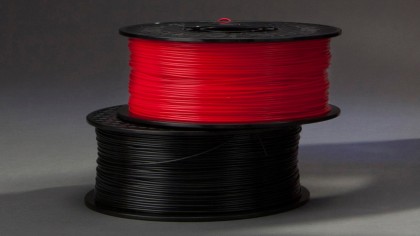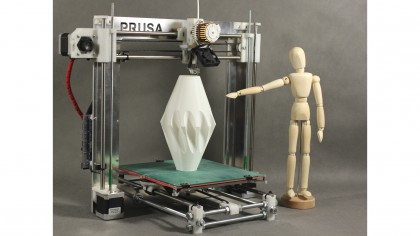Communication tends to be handled by the Printrun package while preparing the final 3D model is done with Skeinforge or Slic3r. As with most external devices, the RepRap runs its own firmware, and again you have a wide choice, with Sprinter and Marlin being popular options.

At this point you'd be ready to calibrate the system, load the plastic print filament and run a test print. You'll use Skeinforge to generate G-code that's sent to the printer by the Printrun Pronterface tool.
Once up to temperature, the 3D printer will slowly build up your object. On a first print you should carefully check for consistent output of the plastic and the positioning of the hotend print nib, and adjust the hotend, steppers and belts accordingly.
Plenty of sites such as thingiverse.com or cncking.com are happy to sell you pre-built 3D models to print. You'll likely want to create models from scratch though, so tools such as Blender and SketchUp are perfectly capable of enabling you to design models that can be converted to G-code ready for 3D printing.
3D scanners can help too, with the likes of the free ReconstructMe and KScan3D using the Kinect.
3D printing in the future
3D printing has it detractors. When a man fired a 3D printed gun, the shot reverberated around the world and focused the spotlight of regulators and governments firmly on 3D printing.
Even before this, 3D printing had attracted the ire of intellectual property lawyers, both in terms of patents surrounding 3D printing technology and the potential future infringements and effective piracy that 3D printers could enable. Disney wouldn't want you printing your own Mickey Mouse statues now, would it?
Are you a pro? Subscribe to our newsletter
Sign up to the TechRadar Pro newsletter to get all the top news, opinion, features and guidance your business needs to succeed!
Even so, the future for 3D printing looks solid. It might currently be a niche, enthusiast or academic plaything, but as the material science advances the range, quality and durability of produced parts will only improve.

In the short term, expect the prices of kits such as the RepRap to drop. Online 3D repro services are already available, and will potentially come to your local shop parade soon enough. Once large manufacturers start releasing 3D printers, expect prices to drop and features to expand even more rapidly. Even Amazon.com now has an Additive Manufacturing products section.
Industrial manufacturers are already using specialist 3D printers for rapid prototyping and are eyeing up the technology to complement existing subtractive processes. One likely real-world use is for small-run bespoke luxury sports cars, where cost and construction speed are not an issue. More mundanely, Ford is already talking about printing spare parts for customers.
There's no doubt that both at home and in industry 3D printers will make their mark in the coming years. It's just a matter of when rather than if we're printing our own future.